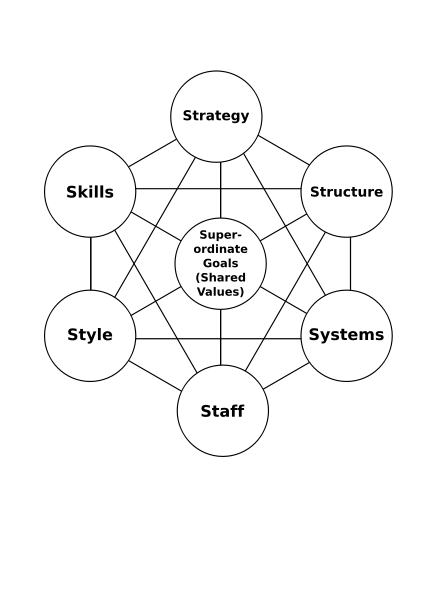Strategic Planning with the Seven S (7S) Management Framework Framework
Seven S (7S) Management Framework is a technique that enables better strategic planning in business.
Strategic planning must be developed within the context of an organization. The Seven S framework shows how strategy fits into the larger picture, and allows management to consider how the direction of the company will affect all facets of the company.
The Seven S's are Structure, Systems, Strategy, Style, Skills, Staff, and Shared Values. Each element is interrelated with the other elements. Therefore, management must consider how changes to one element will affect all other elements.
The 7-S framework is especially helpful with a process redesign or a change management objective.

- Structure: An organization may be structured around customers, products, functions, or other gravitaional centers. Structural elements should be semi-autonomous, yet capable of facilitating interaction amongst one another. (For example, in a functional structure, cross-functional teams will play important roles.)
- Strategy: A company's strategy defines the business within the marketplace - staking out a position of strength that can be maintained for years, if not decades. Strategy begins with a theory that provides puts a company's actions into the context of a larger, explainable process. It attempts to correlate cause and effect within a business context, so that action can be evaluated on the basis of expected result.
- Style (Culture): Refers to the behaviors, beliefs, and approach that is ingrained within the organization. Some corporations have innovative, risk-taking styles, others are highly conservative. A company's style affects who it does business with (i.e., vendors and partners), as well as who does business with it (i.e., customers). If a company's style clashes with its stated strategy (e.g., a conservative culture claiming a strategy of bold change), style is likely to win the day. With concerted effort, style can be changed. However this requires delicacy and patience.
- Staff includes not just the people, but the systems affecting individual and group performance. This includes training, incentives, wages, heirarchy, and intangibles that affect motivation. Although performance reviews and hiring processes are often seen as bureaucratic and unpleasant, they play a vital role in the organization and deserve as much attention as business strategy.
- Skills include core compentencies and secondary competencies that are the aggregate of employees' individual skills. Companies may have funcational skills in engineering, R&D, marketing, or managing customer relationships. Skills may be based on employees' knowledge, or may involve utilization of patents, assets, or systems.
- Systems consist of processes and procedures that organize the flow of information and operations. Financial systems allocate and control the flow of money into (e.g., from customers) and out of (e.g., to employees and vendors) the company. Operational systems manage the flow and processing of good and services. Marketing and sales tracking systems provide information about products, customers, and sales effectiveness. Each system should have a reporting component that enables management to monitor performance, and provides data with which to make strategic and operational decisions.
- Superordinate Goals are unwritten principles that shape behavior. Superordinate Goals are often unwritten, and must be learned based on the behavior and history of the company, rather than what is stated in the company's mission statement.
Other Strategic Planning Frameworks
- 4P's Marketing Mix
- Seven S (7S) Management Framework
- AIDA - Attention, Interest, Desire, Action - Buying Process
- Ansoff's Matrix - Product-Market Growth Matrix - Expansion Strategy
- BCG Growth-Share Matrix
- Bass Diffusion Model - Product Adoption and Innovation
- Blue Ocean Strategy
- Choice Model for Decision-Making Behavior
- Competitive Advantage
- Core Competence - Collective Learning in the Organization
- Cost-Benefit Analysis
- Delta Model
- ERG (Existence, Relatedness, Growth) Theory of Motivation
- Experience Curve
- Framing Effect on Psychology and Marketing
- GE (McKinsey) Matrix
- Growth Phases
- Predicting Industry Evolution and Change
- OODA Loop - Observe, Orient, Decide, Act
- PDCA (Plan, Do, Check, Act) - The Deming Cycle
- PEST Analysis - Political, Economical, Social, Technological, Environmental, and Legal Factors
- Perceptual Mapping - Brand Marketing
- Porter's Five Forces
- Product and Marketing Positioning
- Product Lifecycle (Industry Lifecycle)
- Root Cause Analysis
- SWOT Analysis - Strengths, Weaknesses, Opportunties, Threats
- Technology Adoption Curve
- Value Chain
- Balanced Scorecard
- Benchmarking
- Customer Segmentation
- Pricing Strategy & Price Optimization
- Mergers and Acquisitions (M&A)

SATISFACTION GUARANTEE
We have helped thousands of businesses with their research, and we are confident we can help you, too. We offer a 7-Day Money Back Guarantee on all purchases.

